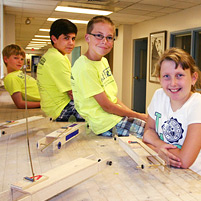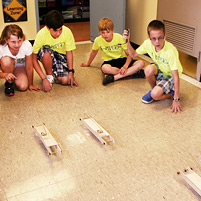C-MITES Bright


Their lemon-yellow tee shirts look like they'd glow in the dark. And their smiles light up the classroom.
But the brightness of their minds is why kids like Sebastian Polanco, a Colombian native who lives in Qatar, are taking summer classes in math and science through Carnegie Mellon University's C-MITES program in Pittsburgh, Pa.
Polanco, one of twelve Qatar students in the program this summer, heard about C-MITES through a friend who took classes before him — and enjoyed it.
With a Carnegie Mellon campus in Doha, Qatar, and a partnership with the Qatar Foundation, Qatar students in Education City have been attending the C-MITES program since 2010.
"It's really fun. My class is building mousetrap-powered dragsters," said Polanco, who wants to one day study aeronautical engineering.
"Math is one of my favorite subjects, and you get to meet new people," added Polanco. "I also like building things, so I was very excited about the mixture of math and science and building things."
Founded in 1992 by Dr. Ann Lupkowski Shoplik, the Carnegie Mellon Institute for Talented Elementary and Secondary Students (C-MITES) is celebrating 20 years of offering classes to academically talented students who have completed 1st to 9th grade.
"We work with 5,000 students every year," said Shoplik.
The curriculum is designed to complement what students have studied in school and provide them with challenges in mathematics, science and the humanities. Class size is limited to 20 students, one teacher and one teaching assistant, and students participate in individualized, small-group and whole-class activities.
Eight-year-old Noah Kessler is unraveling the mysteries of the natural world in an Ecosystems Science class through a variety of games, experiments and fun activities designed around the study of animals and plants, and deciphering the secrets of soil with scientific tests.
A teacher at Kessler's elementary school recommended CMU's C-MITES program to his mother because of Noah's advanced abilities in math and science.
"When I heard the name CMU, I jumped at the opportunity," said Jennifer Kessler. "The class has been outstanding. He's made new friends and gotten lots of hands-on experience. The teacher makes it a lot of fun and so they're really learning something."
She added, "I hope this is just the beginning and that CMU will be a big part of his life."
Other C-MITES classes include Amusement Park Physics, Crime Scene Investigations, Harry Potter's Science Adventure and Alice Programming — one of the late professor Randy Pausch's legacy projects. C-MITES also offers professional development workshops for teachers as well as student testing so that parents can learn more about their child's ability.
Franny McAleer, who teaches one of those workshops, offers strategies that instructors can use to encourage more complex thinking processes and more creative thinking projects.
"Team problem-solving is going to be very important to the children as they become more involved in their chosen field of work," said McAleer. "So I give the instructors a model to work with, in which the students learn their strengths and weaknesses, learn how to talk to people and how to solve a problem. Those are life skills, and you can measure them by observing the children as they interact with each other."
But the best barometer of how well the teachers are getting through is likely the roomful of smiles so commonly found in a C-MITES classroom.
"I was one of those kids who was really bored in school, and that's why I created this program," said Shoplik. "I want kids to be excited about what they're learning."
Photo (l. to r.) Max Cowley, Sebastian Polanco, Eric Junker, and Cecilia Fidler.
Related Links: C-MITES | C-MITES Summer Program 2012 [.pdf] | Qatar Students Join C-MITES | C-MITES on Facebook
